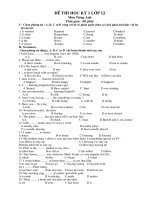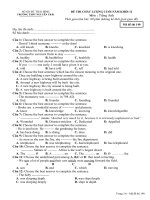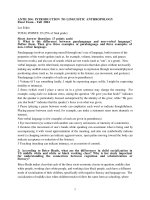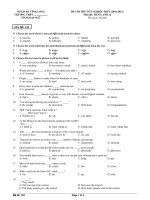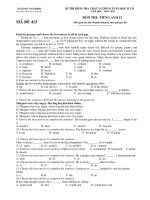De thi tieng anh 12
Bạn đang xem bản rút gọn của tài liệu. Xem và tải ngay bản đầy đủ của tài liệu tại đây (13.89 KB, 4 trang )
ANTH 204: INTRODUCTION TO LINGUISTIC ANTHROPOLOGY
Final Exam - Fall 2004
Lee Eskin
TOTAL POINTS: 25 (25% of final grade)
Short Answer Question: (5 points each)
1) What is the difference between paralanguage and non-verbal language?
Define them. Then give three examples or paralanguage and three examples of
non-verbal language.
Paralanguage involves expressing oneself through one’s use of language, both in terms of the
properties of the words spoken (such as, for example, volume, intonation, stress, and pauses
between words), and also use of sounds which are not words (such as “um”, or a grunt). Non-
verbal language, on the other hand, encompasses expression that takes place without necessarily
making any audible noises; that is, non-verbal language is expression through movement/physical
positioning alone (such as, for example, proximity to the listener, eye movement, and gestures).
Paralanguage (a few examples of each are given in parentheses)
1 Volume (if I say something loudly, I might be expressing anger; softly, I might be expressing
timidity or intimacy).
2 Stress (which word I place a stress on in a given sentence may change the meaning. For
example, using italics to indicate stress, asking the question “He gave you that book?” indicates
that the speaker is particularly focused on/surprised by the identity of the giver, while “He gave
you that book?” indicates that the speaker’s focus is on what was given.
3 Pause (placing a pause between words can emphasize each word or indicate thoughtfulness.
Placing pauses between each word, for example, can make a statement seem more dramatic or
intense).
Non-verbal language (a few examples of each are given in parentheses)
1 Eye movement (eye contact with another can convey seriousness or intensity of a statement).
2 Gestures (the movement of one’s hands while speaking can accentuate what is being said by
accompanying it with visual approximation of the meaning, and also can symbolically indicate
mood (a chopping motion can indicate aggressiveness, open palms moving toward the body can
indicate acceptance or seduction of the listener).
3 Touching (touching can indicate intimacy, or an exertion of control).
2) According to Brice- Heath, what are the differences in child socialization in
US middle white and white or black working class? Why is her study important
for understanding the connection between cognition and scholarization or
literacy?
Brice-Heath makes clear that each of the three socio-economic classes in question, middle class
white people, working class white people, and working class black people, each have a different
mode of socialization of their children, specifically with regard to literacy and language use. The
socialization of middle class white children tends to follow the same form as schooling, where
1
the focus is first on “what-explanations”, then on “reason-explanations”, and then on “affective
commentaries”. At home, these children are first taught through labeling, then through the giving
of background and detail in narratives, and finally through the removal of the interactive
component toward a disposition of the child as an agent in his/her language use. Working class
white children are not taught to engage language in the same way; the written word is presented
to the child, but not linked to everyday life, and not in such a way where the process is explained.
These children tend to succeed at first in the accepted system, but then begin to fall behind.
Working class black children tend to have far less exposure to literature of any kind, and are not
spoken to until they speak. This results in the development of analogical skills and the
encouragement of participatory and expressive use of language. Brice-Heath claims that these
students could succeed in the later parts of the educational system, but do not reach that point
because they tend to fail in the earlier steps. Brice-Heath’s study is very important, because it
may indicate that there is simply a bias to the education system, in such a way that the
socialization of middle class white children is catered to, while a differing system (or a differing
socialization method) could make the working class children more successful. This may be
initially counterintuitive, because it may seem like the education system is well-structure;
however, especially the idea that working class black children would excel at the later tasks but
fail at the earlier ones indicates that the current system, with its cumulative approach, is not
universal. It is reasonable to assume that a different system, where the steps tended to be
reversed, would cater differently and more successfully to working class black children. What
the solution to this is (whether a change in the education system or a change in the socialization
methods) is up for debate, but Brice-Heath’s study is most important because it brings out the
fact that the connection exists in the first place, and that something can be changed to improve
working class ability to succeed in what seems now to be a “middle class white” education
system.
Short Essay Question: (15 points)
1) We have seen that cross- talk can happen between people belonging to
different cultures and that speak different native languages. Do you think that
different dialects could have a similar effect? Do you think we could cross- talk
with people that belong to different sub-cultures in the US and speak different
varieties of English? If you were in charge of planning changes in the US
educational system, what would you do to correct this problem?
I do think that, to some extent, cross-talk does occur between people of different dialects,
and this could pose a unique sort of problem. When cross-talk between people with different
native languages occurs, once there is awareness of the concept of cross-talk, the problem is
easily identified. That is to say, it can be anticipated that people with different native languages
will have a problem communicating, and thus the problem can be corrected for. Cross-talk
between people of different dialects is less extreme, but therefore it is also more subtle and
perhaps harder to notice and correct for. It may be assumed that two people, both of whom speak
English, can communicate fluidly without difficulty. That assumption is often erroneous; there
2
are many differences between dialects, rooted in differences in culture among speakers of the
same language, which can cause problems. A nice example might be between a Texan and a
New Yorker; there are numerous subtle differences in language use between the two, such as, for
example, speed and verbosity. While in Texas a slower drawl, and less precise description, is
expected, in New York one tends to speak more quickly and with greater economy. This
difference, if not recognized as cultural, could easily lead to one interpreting the other as rude and
inconsiderate.
This problem could, hypothetically, be compensated for in the US schools. Classes could
be sure to analyze and highlight the differences between the English spoken there and other
dialects of English. This might reduce the extent to which there is misunderstanding when the
various English-speaking cultures interact, which increasingly they do.
There is, however, a potential downside to this. Teaching the differences in dialects could
highlight cultural differences that aren’t there, or at least aren’t as important as it would then
seem. Thus, to use the example again, someone from Texas, taught things about “New York”
culture, may view New Yorkers as being an “other”, foreign to their own ideals and lifestyle.
This is a necessary cost of cross-cultural compensation for speakers of different native languages
because, more often than not, the differences are frustrating or even debilitating. Furthermore, it
may be somewhat subjective which of the more subtle differences between English speakers are
of sufficient importance, and what the differences really are. Even within a region, there are
many cultures, so teaching about how “New Yorkers” speak excludes the very real possibility
that, say, a Jewish New Yorker speaks differently from an Hispanic New Yorker, who speaks
differently from a Chinese New Yorker. Again, this may be necessary between two differently
native speakers (similarly, there may be many different variations among native Chinese
speakers, but the differences between Chinese and American language and culture are broad
enough that generalization may apply, for practical purposes). Because the differences between
English speakers of different dialects and cultures is more subtle, the generalization required for
compensating for crosstalk may not be worthwhile (not to mention the fact that compensating for
crosstalk is not necessarily an easy task anyway, and may require various resources and great
care to be done right).
Ultimately, I think this is a hard question to answer. However, I can say from personal
experience that, although there have been a few times when I do think I have encountered cross-
talk between native English speakers, I do not think it is a major enough problem to be corrected
institutionally in any kind of a detailed way. Perhaps the best solution is to make sure that
children are educated as to the potential for crosstalk, whether with someone who is a native
speaker of English or not, so that each can anticipate it and correct for it individually.
Please turn in your answer in hard copy, typed.
Your essay should be about 1&1/2 to 2 pages, 1&1/2 spacing. In grading I will consider:
correctness of the answer, detail, appropriate examples given, interesting and relevant personal
commentary, appropriate references to the readings, and a clear writing style. The readings &
3
movie should be referenced when appropriate (you may also quote them as needed, however,
avoid to “fill up” your essay with extensive quotes). When referencing a reading, don’t forget to
indicate author and page number.
DUE 12/20 IN THE DROPBOX (1 COPY) AND BY E-MAIL (1 COPY) BY
11AM
I affirm that I have adhered to the Honor Code in this assignment
Signed ________________________________
4

